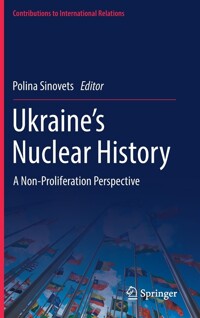
Ukraine's Nuclear History: A Non-Proliferation Perspective
- 개인저자
- Polina Sinovets
- 발행사항
- Cham: Springer, 2022
- 형태사항
- XXI, 264 p. : 24 cm
- ISBN
- 9783030906603
- 청구기호
- 349.82 S617u
소장정보
| 위치 | 등록번호 | 청구기호 / 출력 | 상태 | 반납예정일 |
|---|---|---|---|---|
이용 가능 (1) | ||||
| 1자료실 | 00019252 | 대출가능 | - | |
- 등록번호
- 00019252
- 상태/반납예정일
- 대출가능
- -
- 위치/청구기호(출력)
- 1자료실
책 소개
This book presents a comprehensive overview of Ukraine's nuclear history, beginning from its experiences within the Russian Empire in the early 20th century, through the Soviet period, to the emergence of Ukraine as an independent state that inherited the world’s third-largest nuclear arsenal.
The book discusses the development of the nuclear infrastructure on Ukrainian soil and offers a rich and nuanced background of how Ukraine became an important and integrated part of the Soviet nuclear infrastructure. It further analyzes Ukraine's nuclear disarmament based on extensive primary source material and places the Ukrainian nuclear reversal process in a larger international political context where Russia´s, the United States, and other players´ actions are interpreted in the light of the impact on the current nuclear non-proliferation regime. Finally, the book presents the nuclear-related development after the nuclear disarmament. It describes the integration of Ukraine into the international community and the role of nuclear power in the energy mix of the nation today. Concluding, Ukraine´s adaptation to the new security situation after the Russian annexation of Crimea is described and discussed.
This volume is a must-read for scholars, researchers, students, and policy-makers interested in a better understanding of Ukraine's nuclear history, the political background of the conflict in Eastern Ukraine, as well as of security studies and international relations in general. The work on this book has been supported by the Swedish Radiation Authority (SSM) in the Nuclear History of Ukraine Project (2015-2019).
New feature
This book presents a comprehensive overview of Ukraine's nuclear history, beginning from its experiences within the Russian Empire in the early 20th century, through the Soviet period, to the emergence of Ukraine as an independent state that inherited the world’s third-largest nuclear arsenal.
The book discusses the development of the nuclear infrastructure on Ukrainian soil and offers a rich and nuanced background of how Ukraine became an important and integrated part of the Soviet nuclear infrastructure. It further analyzes Ukraine's nuclear disarmament based on extensive primary source material and places the Ukrainian nuclear reversal process in a larger international political context where Russia´s, the United States, and other players´ actions are interpreted in the light of the impact on the current nuclear non-proliferation regime. Finally, the book presents the nuclear-related development after the nuclear disarmament. It describes the integration of Ukraine into the international community and the role of nuclear power in the energy mix of the nation today. Concluding, Ukraine´s adaptation to the new security situation after the Russian annexation of Crimea is described and discussed.
This volume is a must-read for scholars, researchers, students, and policy-makers interested in a better understanding of Ukraine's nuclear history, the political background of the conflict in Eastern Ukraine, as well as of security studies and international relations in general. The work on this book has been supported by the Swedish Radiation Authority (SSM) in the Nuclear History of Ukraine Project (2015-2019).
목차
Chapter 1. Introduction: Understanding the Nuclear History of Ukraine.- Chapter 2. Ukraine’s Contribution to The Soviet Union’s Nuclear Programme.- Chapter 3. Nuclear Disarmament of Ukraine.- Chapter 4. Nuclear Energy in Independent Ukraine.- Chapter 5. Conclusion: Lessons to Be Learned.
